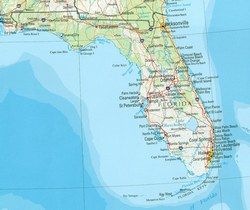Concerns grow that Gulf oil spill could reach Florida Keys
- Submitted by: admin
- Environment
- 05 / 18 / 2010

MIAMI -- As BP engineers worked to contain a deep sea oil spill in the Gulf of Mexico on Monday, scientists tracking the spread of oil on the ocean's surface and underwater expressed concern that powerful currents could carry the crude as far east as Florida and potentially damage sensitive reefs in the Florida Keys.
Doug Suttles, BP chief operating officer, said Monday on NBC's "Today" show that a mile-long tube inserted into a damaged well on the sea floor was funneling a little more than 1,000 barrels - or 42,000 gallons - of oil, natural gas and water a day from the blown well into a tanker ship.
The company and the U.S. Coast Guard have estimated that the deep-sea leaks are releasing about 5,000 barrels of oil a day into the Gulf, though scientists reviewing videotape place the amount as high as 70,000 barrels daily and even BP acknowledges it does not know exactly how much oil is gushing from the damaged well.
The oil spill already has sent miles-long plumes over ecologically sensitive reefs south of Louisiana known as the Pinnacles, about 25 miles north of where the Deepwater Horizon rig exploded April 20, killing 11 people and starting the spill.
Response crews have tried to contain the spreading oil at the surface by using controlled burns, nearly two million feet of boom and more than 580,000 gallons of chemical dispersant.
Marine scientists say diffusing and sinking the oil helps protect surface species and the Gulf Coast shoreline but increases the chance of damaging deep-sea reefs.
Scientists say that the large swatch of oil covering the Gulf already has had a
monumental ecological impact.
Satellite images taken Saturday by NASA's Jet Propulsion Laboratory show that the oil may have already entered the Gulf loop current, which could pull it through the Florida Keys and into South Florida, according to an analysis by Mitch Roffer, a Florida-based oceanographer who runs Roffer's Ocean Fishing Forecasting Service and has tracked the spill.
"I think the threat to South Florida is real and we should get ready," said Igor Kamenkovich, associate professor at the Rosenstiel School for Marine and Atmospheric Science at the University of Miami, who had not seen the images.
"It's hard to predict but if it gets in the loop current, it can happen as quickly as seven to 10 days. ... If it does happen, it is bad news for us."
So far, winds and currents have kept the oil away from the Florida coast, according to the state Department of Environmental Protection.
Jim Lushine, a retired meteorologist who studied the Gulfstream for 15 years at the National Weather Service in Miami, said it is unlikely that oil from the Deepwater Horizon would get caught in the so-called loop current because of prevailing southeasterly winds in the Gulf.
"It would be hard to get anything to move back toward the southeast against the wind," he said.
Lushine said one exception would be independent currents, called eddys, that run counter to the main current. An eddy could capture oil at one point in the current, and then reintroduce that oil closer to the loop current.
Even then, Lushine said, the beaches of northwest Cuba would be a more likely place than South Florida for the oil to wash ashore, he said.
"What happens is the current coming down, it's kind of like, I guess you could use the analogy: If you have an elephant on roller skates, it's kind of hard to turn," he said. "They have enough momentum going that the loop coming southward ends up getting on the beaches of northwest Cuba."
Lushine said such a scenario would pose a greater threat to the Marquesas Keys and Dry Tortugas than to Key West, which is east of those islands.
Once oil is carried south by the loop current, Lushine said, the crude would not "bounce off" the coast of Cuba, but some of it might make the turn and enter the Straits of Florida, the ocean current running between the Florida Keys and Cuba.
Again, however, Lushine said Miami-Dade and Broward County beaches likely would not be seriously affected because oil would then be captured in the Gulfstream, which runs north along Florida's coast.
By DANIEL CHANG AND JAWEED KALEEM - McClatchy Newspapers
Source: www.kentucky.com/
Comments